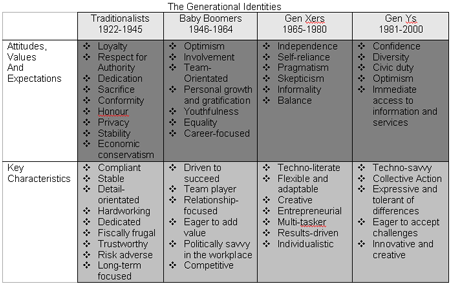Leading a Multigenerational Project Team
Project managers that can create strong, collaborative work environments will achieve more significant project results – be that time, scope or budget. Today’s PM has a role beyond project deliverables; your role is also to get, keep and grow your team members. To do so, it is critical to understand your employee groups; who they are, how they differ from one another and what they expect from you as a project manager. PMs need to create an engaged relationship with all team members to achieve a win-win outcome for the team members and the project stakeholder.
Today’s workplace comprises four generational cohorts: Traditionalists, Baby Boomers, Gen Xers and Gen Ys. Each generational cohort possesses unique values, characteristics, and skills based on its experiences of life-defining events. The commonality of experiences creates generational identities, which are viewpoints that each cohort has on life, love, family, work, politics, and society.

Each cohort’s identity translates into different behaviours in the workplace. These behaviours can be grouped into five organizational factors: relationship with the organization, relationship with authority, relationship with colleagues, work styles and management styles.

With four generations in the workplace, you are faced with four different, and often conflicting, approaches to work. As a project manager, it is important to recognize that members of each generation bring their “generational baggage” with them into the workplace. These perspectives can impact the ability for team members to work well with each other. For example, when a Traditionalist’s respect for authority and directive management style meets a Gen Xer’s relaxed attitude toward authority and informal work style, conflicts can erupt between team members. When generational approaches to work clash, the results are increased turnover, reduced team engagement, and diminished project results.
How can this knowledge be used to improve the performance of your team? Since you play a key role in getting, keeping and/or growing the talent on your team, its important for you to first understand your own generational identity, and how your work style may differ from those you lead. Fundamentally, PMs should think about how they like to work – linear vs. fluid. When we didn’t have as much access to technology as we do today, tasks had to be completed in a strict linear order because there was strong interdependence. It was impossible to complete step three without completing steps one and two. Gen Xers and, in particular, Gen Ys have not been exclusively exposed to a linear world. Technology has allowed the merging of multiple meda and the ability to multi-task easily. Students are found instant messengering 20 friends, while texting three more, while downloading music while doing homework. They bring this work style into the workplace. They expect to be assigned multiple tasks, preferably with little routine involved.
Also, for many PMs, it is important that all team members be in the office every day working at their desks – a remnant of ‘if I don’t see you, you are not working’. For many younger employees, sitting at the desk does not necessarily mean working. They know that they can get as much done with their laptop sitting at their local café as sitting in front of the office PC. Is there an opportunity to be more flexible about in-office work schedules?
Leading a successful project team requires that you develop strategies that maximize the strengths of each generation while managing the differences. This can include the types of tasks on which different team members work. In a session with project managers, one colleague mentioned that she actively allows team members to self-select some of the tasks they wish to complete. What amazed her is that the choices that were made aligned to generational preferences. For example, her more mature colleagues selected tasks that had longer timelines with greater project profile status, while the younger team members wanted to work on tasks where there would be immediate results.
Regardless of age, all employees seek a positive and collaborative relationship with their managers. Beware though; the grace period that Gen X or Gen Y employees will give you to get the relationship right is much shorter than that of Baby Boomers or Traditionalists. The fact is that many leaders exhibit the management style that they experienced, often a top-down command and control approach. In most cases, this approach doesn’t create the level of collaboration that is necessary for today’s business success. Strong communication skills and a constant questioning of your and your team members’ assumptions are steps toward creating productive high-performance teams.
Adwoa K. Buahene and Giselle Kovary are co-founders of n-gen People Performance Inc. n-gen is a performance consulting company that provides performance solutions layering on a generational perspective. It specializes in recruitment and orientation, total rewards programs, employee brand promises, career-pathing, learning and development, mentoring, performance management, succession planning and management practices. For more information, visit www.ngenperformance.com.
redditsave.io
… [Trackback]
[…] Information to that Topic: projecttimes.com/articles/leading-a-multigenerational-project-team/ […]
โฉนดที่ดินเข้าธนาคาร ไหนดี
… [Trackback]
[…] Here you can find 15884 additional Information to that Topic: projecttimes.com/articles/leading-a-multigenerational-project-team/ […]
torqeedo electric motor|achiles boat|achillies inflatable boat|yamaha vmax 2021|avon boats|achilies boats|achillies inflatable boats|200 hp merc outboard|avon inflatable boats|avon boat|avon inflatable boat|honda boats|200hp mercury outboard|achillies inf
… [Trackback]
[…] Information on that Topic: projecttimes.com/articles/leading-a-multigenerational-project-team/ […]